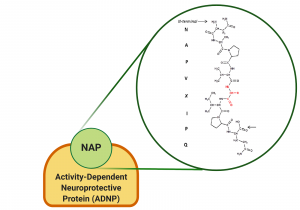7.4.1 – NAP in Providing Neuroprotection
NAP is Derived from ADNP
Activity-dependent neuroprotective protein (ADNP) was found to be the only protein to decrease in AD patients when compared with control populations. An intelligence test performed on elderly individuals diagnosed with AD was found to be parallel to the reduction in ADNP in their system. How is ADNP related to the function of the brain and why is the reduction of ADNP is associated to degenerating brain disease?
Initially, ADNP was reported to have function relating to cell differentiation and neuronal growth. It was reported to be a type of cell mediator of a larger intestinal peptide. The peptide function was to provide neuroprotection and to assist with proper brain development in the fetus. ADNP was abundant in a few parts of the brain such as the hippocampus, the cerebral cortex and the cerebellum. Although the central function of ADNP is still unclear, it has been reported in a study related to cell survival, by maintaining the structure of the cell through mediating interactions between different proteins such as the interaction between p53 and chromatin. Since p53 is associated with apoptosis, mediating this interaction allow cells using ADNP to survive longer.

NAP (NAPVSIPQ) is an octapeptide sequence derived from ADNP. NAP has been used in mouse models as a potential treatment for AD. Since biomarkers of AD are still widely in development, making drugs without a confirmed target would be counterproductive. Therefore, researchers are now focusing on deriving peptides from the human body itself, so to reduce problems with finding the perfect target site. The peptides that are chosen are able to mimic ADNP and trick the body into assuming that it has a high level of ADNP to stabilize the pathways of providing neuroprotection.
Learn More About NAP
Mechanism of Action for NAP
NAP interacts with microtubules and enhances the effect of ADNP binding to microtubules, which consequently improves neuroprotection and axonal transport. This enhancement is beneficial for microtubules since it results in fewer tau proteins being phosphrylated, leading to a lower deposition of abnormal tau proteins in the brain. On a neuronal level NAP prevents the death signal from being transmitted and functions to restore the microtubule network in cases where the signal has already been initiated.

